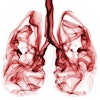
Machine-learning fractional flow reserve CT (FFR-CT) may help clinicians overcome key barriers to conventional FFR-CT, including the lengthy amount of time required to obtain measurements, according to a presentation at the 2018 International Society for Computed Tomography (ISCT) symposium.
There are a number of solutions being developed to address the clinical and nonclinical challenges of using FFR-CT to determine the degree of stenosis in an artery, presenter Dr. Koen Nieman, PhD, from Stanford University told meeting attendees. One possible method is to use the computing power of artificial intelligence to help speed up the collection of FFR measurements.
To that end, Nieman and colleagues conducted a multicenter study evaluating the diagnostic performance of a machine-learning FFR-CT algorithm (syngo.via Frontier, Siemens Healthineers) for identifying obstructive coronary artery disease (CAD). Their work was recently published in Circulation: Cardiovascular Imaging.
"Machine learning-based FFR-CT worked just as well as [conventional FFR-CT], the advantage being that it calculated the measurements in a matter of seconds," he told ISCT 2018 attendees. "I think this technology cannot be ignored and will be a part of our practice in the future."
Nearly instant calculations
 Dr. Koen Nieman, PhD, from Stanford University.
Dr. Koen Nieman, PhD, from Stanford University.Over the roughly 10-year history of FFR-CT, several clinical trials have shown that incorporating the technique into clinical practice can help reduce the number of unnecessary referrals for conventional invasive coronary angiography by a wide margin. However, standard FFR-CT is a computationally demanding procedure that relies on an offsite supercomputer to perform its calculations in a process that can take up to four hours to complete.
Seeking to improve the efficiency of FFR-CT, Nieman and colleagues tested the accuracy of a machine-learning FFR-CT algorithm. The algorithm inputs the morphological features of the coronary artery disease evident on a patient's CT scans into a regular workstation, and then calculates FFR based on this morphology instead of using computational fluid dynamics (Circ Cardiovasc Imaging, June 2018, Vol. 11:6, e007217).
"I just found it a fascinating idea -- to let go of computational fluid dynamics, which is something that makes FFR-CT slower and more complicated, and to really go for the anatomy, and then based on the anatomy, to say this is what we think the consequence will be of the cumulative hemodynamic obstruction," Nieman told AuntMinnie.com.
For the study, called Machine Learning-Based CT Angiography-Derived FFR: A Multi-Center Registry (MACHINE), Nieman collaborated with researchers from five different institutions in the U.S., Europe, and Asia to compare machine-learning FFR-CT with conventional FFR-CT.
Among 351 patients examined, the accuracy of both techniques was nearly identical in the detection of intermediate stenoses, and they both outperformed traditional coronary CT angiography (CCTA) evaluation.
| CCTA, FFR-CT, and machine-learning FFR-CT for diagnosis of obstructive CAD | |||
| Measure | Coronary CT angiography | FFR-CT | Machine-learning FFR-CT |
| Sensitivity | 88% | 82% | 81% |
| Specificity | 38% | 76% | 76% |
| Accuracy | 58% | 78% | 78% |
FFR-CT and machine-learning FFR-CT demonstrated a similar diagnostic performance, but machine-learning FFR-CT was capable of providing measurements much more quickly -- almost instantaneously. This additionally gave the clinicians plenty of time to perform the manual portion of FFR-CT -- coronary artery segmentation -- multiple times, if they felt they needed to refine their segmentation.
"With machine-learning FFR-CT, you can actually interact with your dataset," Nieman said. "Let's say, for instance, you perform a segmentation and you get your results, but you doubt that it's correct; then you can go back and change your segmentation a little bit and then run it again very quickly. I think that will be one of the big implications of machine-learning FFR-CT."



















